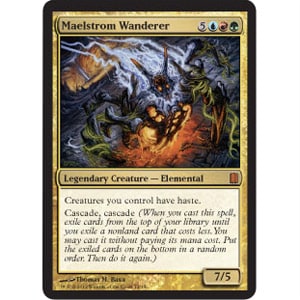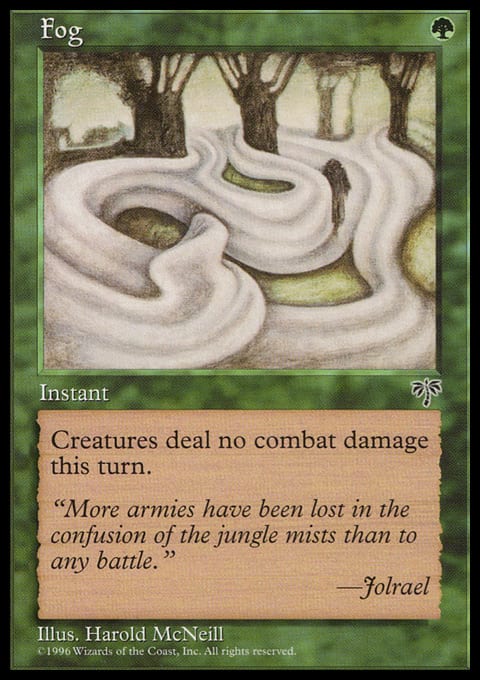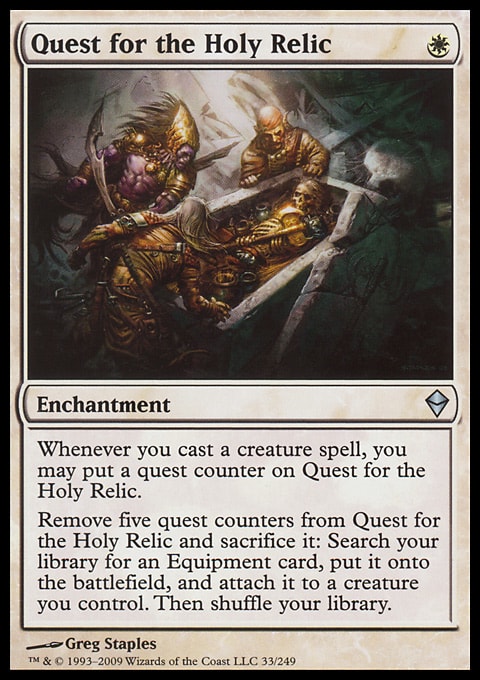Most frequent Magic players have one or two friends they consistently play cards with. You know whom I mean. They’re the ones you play with nearly every week. Like Frodo and Sam, you attend prerelease events together, play Pack Wars on your lunch breaks, or meet up at the local shop for some Commander.
My Samwise Gamgee is my good friend Brad. In the summer of 2010, he left our home state of snowy Michigan for the sunny shores of California in order to chase a Master’s Degree. The moment he told me he was leaving was bittersweet. Of course, I was glad he was pursuing his education, but who the heck was I supposed to play Magic with? A friend who lived more than two thousand miles away?
That’s when we decided to build a Cube together. Here’s how we did it along with some thoughts on how you can do it, too.
One Doc to Rule Them All
I need to thank the geniuses behind Google Docs because they made our joint Cube possible. After Brad left, we opened up a Google Doc entitled The Collab Cube of Doom and started building a monster. Like a pair of Dr. Frankensteins, we labored over this Cube for months and screamed, “It’s alive!” when it was finally finished.
Before building our monster, we agreed on goals regarding what kind of Cube experience we wanted to create. We also laid out some ground rules for how we would go about submitting cards. These two items are the first steps on the road to building a Cube with someone else. Neglect them at your own peril.
The Ground Rules
Here’s our list of rules. What would yours look like if you were building a Cube with a friend?
- Every card that went into the Cube had to be agreed upon by both people. Either of us could nominate any card we wanted, but the other person had automatic veto power.
- Each person could only put two cards into the doc at a time. This helped the Cube to grow slowly and organically rather than having each of us just open up the doc and dump in every good card that came to mind. It was more organic this way because we would often add cards in response to what the other person added. We watched themes develop in the Cube over time, and we made decisions based on those themes. (e.g. I added a couple of token-makers in Myr Battlesphere and Rith, the Awakener, prompting Brad to add Mutilate.) We agreed to exceed the two card limit only if we were submitting a whole cycle for consideration (for instance, the Ravnica signets).
- To enable voting on cards, we created a field next to each card name called Reasons. In this field, the person submitting the card could record his justification for its inclusion in the Cube. After entering a card into the Cube, we would highlight the Reasons field in yellow. The other person would read the reasons and had three choices: He could remove the yellow highlighting, indicating that the card was accepted; add a response comment and highlight the field in another color, indicating that a conversation was going; or highlight it in red, indicating a rejection, and include comments as to why it was rejected. The image below is an example of what our doc might look like on any given day.

The Goals
Every Cube design team will have different goals. This is our list. If you created a Cube with a friend, what would your goals be?
- Our primary goal for the cube was fairly straightforward: We wanted every single card we drafted to feel like a game-changer. In every game, on every turn, we wanted to be casting bombs that would dramatically swing the advantage from player to player.
- Our secondary goal was to include weird, tricky, or hard-to-play cards that aren’t often included in Constructed, sixty-card formats. This includes cards such as Timesifter, Gate to the AEther, and Shared Fate. All three of these cards qualify as game-changers to us. While they might not be splashy bombs such as Liege of the Tangle or Planar Cleansing, they change the state of the board pretty dramatically and were therefore included.
The Cube of Doom
Our quest for a Cube of game-changers led us to building a pretty long, crazy list of bombs. Throughout our Reasons section on our Google Doc, we would say things like, “This is a game-changer because . . . ” or, “If you dropped this card, the game completely swings . . . ”
This means our Cube is loaded with high-priced, game-swinging cards. In addition to what’s listed above, some other examples of our game-changers include:
- Sway of the Stars
- Malignus
- Once More with Feeling
- Maelstrom Wanderer
- Army of the Damned
- Nicol Bolas, Planeswalker
- Sheoldred, Whispering One
- Geth, Lord of the Vault
In addition to Timesifter, Gate to the AEther, and Shared Fate, here’s a list of some of some of the other tricky or hard-to-play cards that have cycled in and out of our Cube:
- Storm Cauldron
- Mana Breach
- Manabarbs
- Jinxed Idol
- Jinxed Choker
- Saprazzan Bailiff
- Worldfire
- Last Stand
Realistically, you can’t have a Cube that consists only of cards like this. When every card is overpowered or strange, your Cube quickly becomes unplayable. So, we agreed that if our Cube had to include cards that weren’t game-changers, they at least had to be enablers—things that would help us bring the game-changers online. Naturally, this means we have a ton of mana ramping and mana fixing. Some examples include cards you’d expect, such as:
- Coalition Relic, Gilded Lotus, Manalith
- The cycle of Ravnica Signets
- The cycle of Refuge lands from Zendikar
And then we’ve also included some other enablers that you might not expect:
- Morgue Toad
- Tinder Wall
- The Familiar cycle from Planeshift
If you are building a Cube with a friend, you may run into this problem as well. Start thinking through what type of support cards you’ll need to include in order to achieve your goals.
Subthemes Emerge and Archetypes Disappear
We discovered that one major subtheme exists in our Cube besides just the mana acceleration and mana fixing. It’s a natural bi-product of our two goals: a focus on multicolored decks.
Brad and I have found that game-changers often come in multicolored packages. While our card list fluctuates from time to time, the Cube of Doom usually contains around fifty mono-colored cards of each color, fifty colorless, cards and over seventy-five multicolored cards. After starting the Cube of Doom, we realized we wanted the majority of our decks to be constructed with three or more colors so we could easily play all the bombs we were including. This led us to including balanced numbers of cards that represent every three-color shard from the Alara block and every three-color pairing of enemy colors (e.g. Numot, the Devastator represents the three-color enemy pairing of red, white, and blue, and Damia, Sage of Stone represents the three-color enemy pairing of green, blue, and black). We also included a balanced number of cards to represent all ten of the Ravnica guilds. On top of that, we’ve included a couple of five-color cards and four-color cards.
A Cube loaded with fatties, expensive bombs, and weird cards that mess with the board is all well and good, but it forced us to eliminate some common archetypes. Our Cube does not contain enough cards to effectively draft:
- Aggressive “weenie” decks – We took out almost all the high-powered cheap creatures and opted instead for enablers. Our Cube does not contain copies of Bloodbraid Elf or Vault Skirge. It would be impossible to construct a weenie deck with the Cube of Doom in any color or pairing. As you design your cube it will help you make stronger card decisions if you are aware of what strategies you may be inadvertently excluding along the way.
- A focused burn deck – We have a few staples, such as Lightning Bolt and Cone of Flame, but not many others. We wanted to include enough burn spells so that drafting red still feels like drafting red, but not so much that you could truly build a burn deck.
- Mill strategies or Turbo Fog – We have a few of the pieces you’d need (Otherworld Atlas, Fog, Jace Beleren) but not enough to actually draft the archetype. (That said, we’ve had many a forty-card duel end because somebody was milled out. Sword of Body and Mind is almost always the reason.)
How Does It Play?
After three or four months of building it, Brad and I finally were able to compile the Cube of Doom for the first time during a Christmas vacation. One detail I haven’t mentioned yet about Brad: He’s my brother-in-law. He was back in Michigan for a week visiting the family when we first constructed our Cube. He and I had ample time to combine our contributions and see the monster we had created in action.
It was awesome!
It does what we set out for it to do: It enables us to play big, fat, game-changing cards on a regular basis. Our games regularly swing back and forth, with each of us dropping bomb after bomb. We often found ourselves staring at really tricky board states and playing three or more colors in our decks.
We started building the Cube of Doom in 2010. Since then, we’ve played the Cube numerous times. After Brad earned his degree, he moved back to Michigan, and now we can compile the Cube of Doom whenever we want. What more could a Cube nerd ask for?
It’s Time for Your Quest to Begin
I’m willing to bet that other players might hate our Cube if they played it. Not everyone appreciates a steady flow of overpowered game-changers. And the absence of some archetypes would probably rub a few players the wrong way, but we love our Cube. To each his own. That’s one of the great things about cubing—and Magic in general: We can make the game play however we want to.
But it begs the questions: What Cube would you build with a friend? If you and a buddy (or a brother-in-law) had the opportunity to construct a Cube via Google Docs, what would it be like? What goals would you set for the Cube? What restrictions would you put in place in order to achieve those goals?
I encourage you to find your Samwise Gamgee and give Cube design a try. You might not need to look any further than your family tree. And though you may not have to walk to Mount Doom, you will most definitely build your own “Cube of Doom.”































